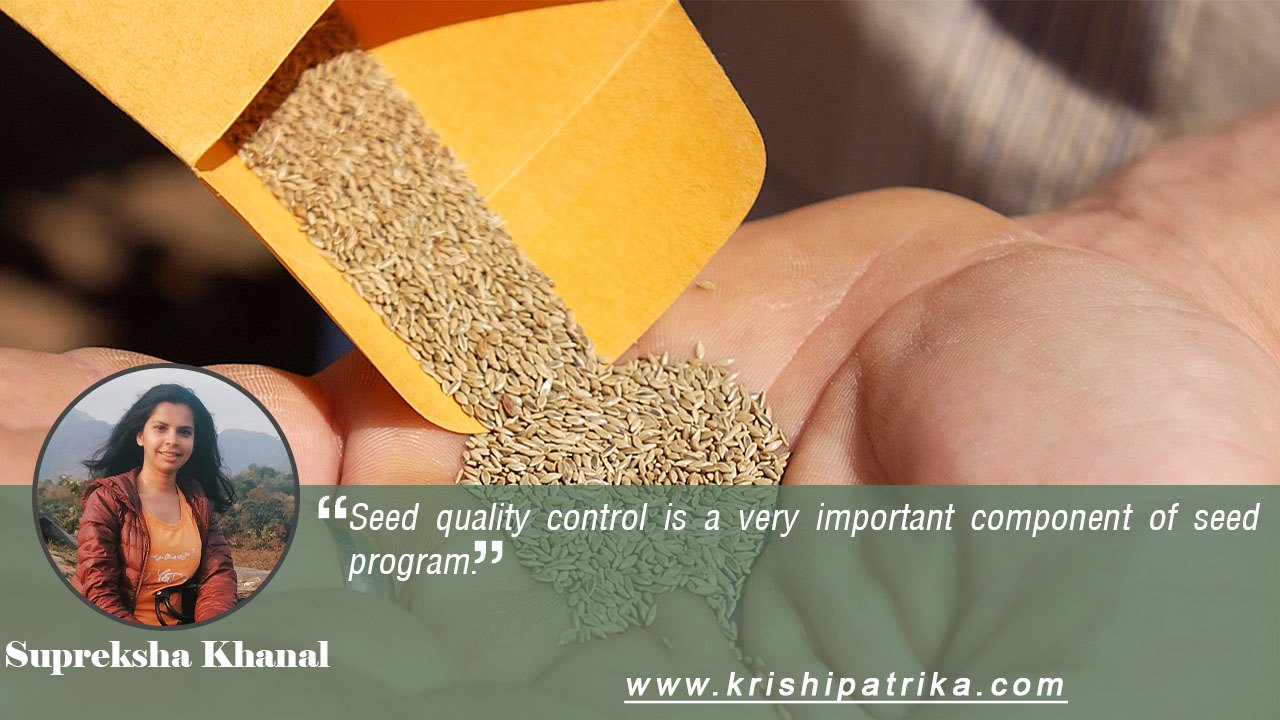
Seed certification is a legally organized program for quality control of seed and propagating materials of genetically distinct crop varieties during seed multiplication program. In certification program seed is produced by farmers through using careful quality control mechanisms like field inspection during growing season and seed inspection following harvest by legally authorized agency. High quality seed should equal or exceed the bench mark of standards set for genetic and physical purity, germination, vigor and should be free from seed borne disease and insect pest damage.
High quality seed can be produced by controlling the production protocol of seed certifying agency in two ways: 1) By monitoring seed multiplication and processing operations to avoid or minimize the risk of mechanical or genetic contamination for maximize biological efficiency of seed crop.
2) By fixing minimum field and seed standards of different crop species to facilitate certification and assuring dependability of the product to the users.
Seed quality control is a very important component of seed program. Without controlling the quality of seed during production, cleaning, grading, drying, storage and marketing operations, it is not possible to carry forward a seed programme. Quality control aims to make available the seeds of improved varieties and hybrids of assured standards to the farmers so as to improve the agriculture production and productivity. Seed quality is usually controlled through seed legislation, certification and seed testing.
Objective of certification : To ensure genuineness and quality of seed to the users or purchasers to increase the production and productivity of any crop is the main objective of seed certification.
Organization of certification:
The organization and structure of a seed certification agency differ country to country. In some country it is done by either Department of agriculture or State Agriculture Universities or Crop Improvement Association etc. In Nepal, the bylaws of Seed Act (1988) have been approved by the parliament. Seed certification is done by seed certification agency i.e. Seed Quality Control Center (SQCC) under Ministry of Agriculture and Cooperatives of Nepal.
Procedures:
- Application are examined,
- Field is inspected,
- Seed deliveries to the processing plants are also inspected,
- Tagging, labeling and sealing is followed.
The process of seed certification is initiated by an application given by the seed grower for certifying the seed to the certifying agency. If a seed lot ratifies the prescribed purity and quality requirements, the certification authority issues suitable tags of certification for affixing them to the seed bags under certification. The inspections are conducted at three levels:
1) Field inspection 2) Inspection during seed processing and 3) Laboratory testing
- Field inspections: The purpose of field inspections is to examine the seed crop in the field and to determine its suitability for certification. Seed certification inspectors do field inspections. During field inspections, observations are made on isolation distance, the presence of off-type plants, error in planting, planting ratio in the case of hybrid varieties, presence of objectionable weeds and plants of other crops, and the incidence of disease transmissible through seed. Generally 2-4 inspections are carried out at different phonological stages of crop. Foundation seed crops are also subjected to the same number of field inspections as those for certified seed, however, the requirements are more strict. During field inspections, objectionable weed plants and plant infected by designated (seed borne) diseases are specifically monitored.
- Inspection during seed processing : This inspection is done to determine whether the seeds have been dried to appropriate moisture level, and whether the correct processing procedure is being followed or not. Another purpose of such inspections is to determine whether appropriate care is taken to avoid mechanical mixtures during seed processing. This is not common practice in Nepal.
- Laboratory testing or seed tests: Laboratory testing consists of series of seed tests designed to determine the quality seed. Before certification, seed lots are subject to test to determine the quality of seeds. A) Purity test b) germination or seed viability test and c) moisture content test. Seed tests are conducted on small sample sizes (about 25 gm) so it is essential that the samples used for seed tests are representative of the lot and the samples should be drawn randomly from the seed lots. a) Purity test: It denotes the percentage of seeds (by weight) belonging to the variety under certification. It is calculated by arithmetic method.
Cultivar purity test: This test determines the amount of seeds of other varieties of the same crop in a seed lot. The sample size should be large, and it can be conducted by examination of seed in the laboratory, examination of seedlings grown in a growth chamber or green house and field plot tests or grow-out tests.
- b) Germination and viability test: It is determined as percent of seeds that produce or likely to produce seedlings under suitable environment. Germination test and tetrazolium chloride test are two tests for this purpose. Germination test is conducted in the controlled condition, the result is based on the percentage of seed that produce healthy root and shoot. In tetrazolium method, treating the seed with the chemical 2,3, 5-triphenyl tetrazolium chloride determined the percentage of viable seeds in short. It is colorless but develops intense red color when living cells reduces it. This test is completed in about within 4 hours, but it is difficult to apply in crop with small seed size.
- c) Moisture test: It is determined as percent water content of seeds. The moisture content is determined by drying the seed samples in an oven or with the help of moisture meter. Moisture meter measures the resistance of seeds to an electrical current, which varies with the moisture content. The use of moisture meters requires calibration and a certain degree of technical skill on the part of the user. But moisture meter are very efficient and extremely rapid, so a large number of samples can be handled in a relatively short period. Moisture content is determined easily and very fast by electronic moisture meters also.
After doing all the above tests, if the seed lot under test meets the requirements set by the concerned country authority, then the certifying agency duly certified the seed lot, and the seed is sold for cultivation. If the requirements are not met, the particular seed lot is not permitted to sale and grows commercially.
Importance of seed certification
- To maintain availability of seeds of high quality of different kinds and varieties to the farmers through certification.
- To ensure the acceptable standards of seed viability, vigor and purity and germination percentage.
- Useful for the provenance test
- Help to achieve the objective of plantation
- Knowing the quality of mother tree
- Vigorous of the growth and the degree of suitability to the site of plantation.
- Better yield, drought tolerance, herbicide tolerance and pest tolerance with improved traits.
- Play important role as an important risk management tools.
Hence, the above are the importance of the seed certification.









